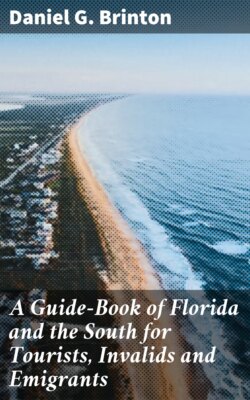Читать книгу A Guide-Book of Florida and the South for Tourists, Invalids and Emigrants - Daniel G. Brinton - Страница 12
На сайте Литреса книга снята с продажи.
Richmond.
ОглавлениеHotels.—Ballard House ($4.00 per day); Spottswood, Exchange (each $2 per day); Ford’s Hotel on Capitol Square ($2.50 per day); St. Charles ($2.00.)
Boarding Houses.—Arlington House, corner Main and 6th street; Valentine House, on Capitol Square; Richmond House, corner Governor and Ross streets; Mrs. Bidgood’s, 61 East Main street; Mrs. Brander, 107 E. Franklin street, (all about $12.00 per week).
Telegraph Offices in Spottswood and Exchange Hotels.
Reading Rooms at the Y.M.C.A. The Virginia State Library was pillaged in 1865, and the Virginia Historical Library burned.
Theatre.—The Richmond Theatre has a respectable stock company, and is visited by most of the stars of the stage.
Booksellers.—West & Johnson, 1006 Main St., (Brinton’s Guide-Book.)
Churches of all denominations.
Richmond derives it name from the ancient burgh of the same name on the Thames. The word is supposed to be a corruption of rotre mont, and applies very well to the modern namesake. Like Rome, it is seated upon seven hills, and if it has never commanded the world, it will be forever famous as the seat of the government of the whilom Confederacy. It is situated at the Great Falls of the James river, on the Richmond and Shoccoe hills, between which flows the Shoccoe creek.
In the early maps of the colony, the site of the present city is marked as “Byrd’s Warehouse,” an ancient trading post, we can imagine, said to have stood where the Exchange hotel is now built. In 1742 the city was established, and has ever since been the chief center of Virginian life.
The capitol is a showy edifice, on Shoccoe hill. The plan was taken from the Maison Quarre, of Nismes, with some modifications, among others the Doric pillars. It stands in the midst of a square of eight acres. In this building the Confederate Congress held its sessions. It contains, among other objects, a well cut statue of Washington, dating from the last century, “fait par Houdin, citoyen Francais,” as we learn from the inscription, and a bust of Lafayette. Two relics of the old colonial times are exhibited—the one a carved chair which once belonged to the house of Burgesses, of Norfolk—the other a huge stove, of singular shape, bearing the colonial arms of Virginia in relief. This latter is the product of a certain Buzaglo. It is eight or ten feet high, and slopes from base to summit. A letter of the inventor is extant, addressed to Lord Botetourt, in which he speaks of it as “excelled anything ever seen of the kind, and a masterpiece not to be excelled in all Europe.”
In the square around the capitol is an* equestrian statue of Gen. George Washington, constructed by Crawford, and erected February 22, 1858. Its total height is sixty feet. Around its base are six pedestals, upon which are figures of Thomas Jefferson, Patrick Henry, Marshall, Gov. Nelson, George Mason and Andrew Lewis, the latter an Indian fighter, once of celebrity in Western Virginia.
To the left of this is a small statue of Henry Clay, erected by the ladies of Virginia, made by Hart, and inaugurated in 1860.
On the eastern side of the square is the residence of the Governor, and on another side the City Hall, a handsome edifice with Doric columns.
St. John’s Church, on Richmond Hill, is the oldest church edifice in the city. The tower and belfry are, however, a modern addition. From its church-yard, dotted with ancient tombs, one of the most charming views of the city can be obtained. In this church, in 1775, the young and brilliant orator, Patrick Henry, delivered his famous oration before the Virginia Convention, which concludes with the famous words, “Give me liberty, or give me death.”
The Tredegar Iron Works, Libby Prison, at the corner of Thirty-fifth and Main streets, Belle Isle, and Castle Thunder, will be visited by most tourists as objects of interest. *Hollywood cemetery, near the city is a quiet and beautiful spot, well deserving a visit.
In the fire of April 2, 1865, about one thousand buildings were destroyed, but the ravages of that disastrous epoch are now nearly concealed by new and handsome structures.
The Falls of the James are properly rapids, the bed of the river making a descent of only eighty feet in two miles. They furnish a valuable water-power.
*Hollywood Cemetery, one mile from the city, is a spot of great natural beauty. Here lie the remains of Presidents Monroe and Tyler, and other distinguished men, as well as of many thousand Confederate soldiers. A rough granite monument has recently been erected in memory of the latter.
Butler’s Dutch Gap and Drewy’s Bluff, and the famous battle fields near the city, will be visited with interest by many.
Those who would visit the mineral springs of Virginia, will find ample information in Dr. Moorhead’s volume on them, or in that by Mr. Burke. Both can be obtained of West & Johnson, booksellers, Main street.
The Natural Bridge, one of the most remarkable curiosities in the State, is best approached by way of Lynchburg, from which place it is distant 35 miles, by canal.
